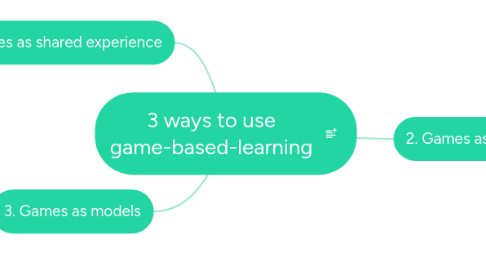
1. 1. Games as shared experience
1.1. Minecraft
1.1.1. open world game that promotes creativity, collaboration, and problem solving in an immersive environment where the only limit is your imagination
2. 3. Games as models
2.1. Werewolf
2.1.1. You should have an equal number of cards to the people playing. You should always have 1 Seer, 1 Doctor, and 2 werewolves and the rest of the players should be Villagers. If you have a large group (16+), you can replace a Villager for an additional Werewolf
2.2. Pandemic
2.2.1. Based on the premise that four diseases have broken out in the world, each threatening to wipe out a region
3. 2. Games as text
3.1. Firewatch
3.1.1. Open-world game about being a park ranger. A mystery set in the Wyoming wilderness, where your only emotional lifeline is the person on the other end of a handheld radio.
3.2. Life is strange
3.2.1. Emotional tale of friendships and bullying at a private school
3.3. Her story
3.3.1. Nonlinear, police procedural whodunit
3.4. 1979 Revolution: Black Friday
3.4.1. A political thriller set in the Iranian Revolution
3.5. Walden, a Game
3.5.1. Based on Henry David Thoreau’s book
3.5.2. first person simulation of the life of American philosopher Henry David Thoreau during his experiment in self-reliant living at Walden Pond. The game begins in the summer of 1845 when Thoreau moved to the Pond and built his cabin there
3.6. Hero's journey
3.6.1. Harry Potter
3.6.2. Hunger Games
3.6.3. Brothers: A Tale of Two Sons
